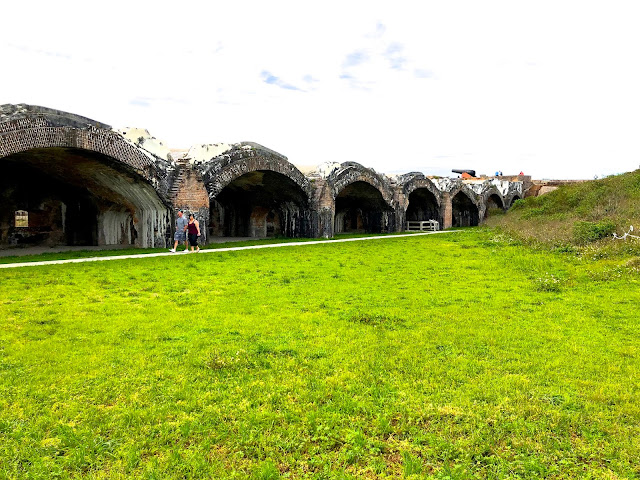Florida's Gulf Islands National Seashore preserves natural and historic resources along the Gulf of Mexico barrier islands of Florida and Mississippi. One of the historic resources is Fort Pickens.
Pensacola Bay in Florida's Panhandle had long been considered a vital port with its depths ranging from twenty to sixty-five feet and its length of 12 miles. The Treaty of 1819 with Spain ceded the area to the United States, and by 1825, legislation was passed to establish a naval yard and depot on the bay. Fortifications to protect the bay were deemed vital and Ft. Pickens and its sister forts were built.

The best location for a fort was on the western point of Santa Rosa Island, a barrier island which provided natural protection to the bay and mainland Florida, and also commanded the approaches to the channel.
In May of 1828, the government acquired 998 acres on the island and workers broke ground in May of 1829, finishing in October of 1834. Workers consisted of both skilled mechanics and unskilled laborers, many of whom were slaves rented from their masters.
Here's a photo taken during its construction...
The fort was named for Brigadier General Andrew Pickens of South Carolina who fought in the Revolutionary War. The fort was de-commissioned in 1947.

Over 21 million bricks were used in its construction, making it the largest brick structure on the Gulf of Mexico. It contained the latest technologies in coastal defense, design and, weaponry and made America virtually impregnable -- for a time.

Fort Pickens was of a Pentagonal design, with broader western walls to provide a wide range of fire over the bay.
The fort had a counterscarp to the east side to create a defensive moat in the event that a land invasion came from the west. The westernmost Bastions were also equipped with chambers filled with explosives which could be detonated as a last-ditch-effort to save the fort from invaders.
This U.S. Seacoast 32-pounder smoothbore cannon, cast in 1823, could fire a 32 pound solid shot over a mile, shooting through the embasure (opening) in the outer wall.
The diagram shows how the recoil was absorbed on the wooden platform...
The fort remained in Northern hands during the Civil War, and that was the only time its guns were fired. In November of 1861, the Union troops at Fort Pickens bombarded Confederates who had occupied Forts McRee and Barrancas across the bay. The confederates fired back but the Union prevailed, and the confederates left their posts in the spring of 1862 needing their troops elsewhere. The number and caliber of guns and weight of metal brought into action in this battle rank with the heaviest bombardments in the world's history!
New technology in weapons required replacing the guns with the massive 15-inch Rodman smoothbore which was installed in 1868. It weighed 50,000 pounds and had a maximum effective range of three miles. Its 15-inch explosive shell weighed about 300 pounds, or it could fire a 400 pound solid shot. The circular iron tracks allowed it to fire in any direction. 8 and 10 inch Rodmans were also installed, but all these were gradually replaced by rifled, breech-loading artillery by the late 1880s.
The fort was also on the brink of war with Spain after the USS Maine was sunk in Havana Harbor, Cuba, in February of 1898. Fearing the new torpedo boats, the Corps of Engineers mined the harbor entrance. The system remained until a hurricane damaged it in 1926.
But the fort had become antiquated by the 1890s because the latest rifled artillery could penetrate its brick walls, so in 1898 the fort was updated with reinforced concrete and steel walls. The addition was called Battery Pensacola and was actually a fort within the existing fort. It had two 12-inch rifles on carriages seen below. After firing, the gun could disappear behind walls. Its 1070 pound shells could hit ships eight miles away!

The fort's brick walls and cast-iron guns became obsolete. Harbor defenses required steel guns in low-lying concrete batteries, so Battery Trueman with 3 inch, rapid fire guns was commissioned in 1905. These guns were later moved to the newer Battery Cullum in 1943 to protect against German U-Boats.
Several other batteries were later added to the island as separate installations, and the fort provided protection during both World Wars I and II.
The most powerful guns were Battery Langdon's 12 inch projectiles which could be fired 17 miles out to sea. It is reported that many soldiers would bleed from the mouth and ears because of the concussion from these guns.
Battery Langdon was begun in 1917 and completed in 1923. It was covered with soil and foliage during World War II to camouflage it from enemy aircraft.
Volunteers offer re-enactments of cannon firing...
I took all these photos when I was here for a week of volunteer trail work on the Florida Trail whose northern terminus is at Fort Pickens. Here's a sunset photo I took while there...



















